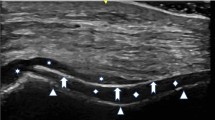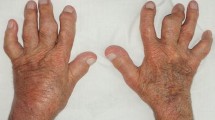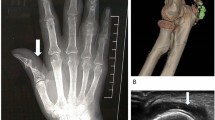Abstract
Gout flares, caused by monosodium urate crystals in joints, are debilitating and linked to poor health outcomes. Gout prevalence increases with age, but effective treatment is available even in those with associated renal, cardiovascular and metabolic comorbidities. Treatment includes immediate pain relief with low-dose colchicine, non-steroidal anti-inflammatory drugs, or oral/parenteral corticosteroids; with parenteral corticosteroids useful in older patients. Lifelong urate-lowering therapy and patient education, are typically recommended to reduce the risk of recurring gout flares.
Similar content being viewed by others
References
Day RO, Lau W, Stocker SL, et al. Management of gout in older people. J Pharm Pract Res. 2019;49(1):90–7.
Richette P, Doherty M, Pascual E, et al. 2016 updated EULAR evidence-based recommendations for the management of gout. Ann Rheum Dis. 2017;76(1):29–42.
Kumar M, Manley N, Mikuls TR. Gout flare burden, diagnosis, and management: navigating care in older patients with comorbidity. Drugs Aging. 2021;38(7):545–57.
Vargas-Santos A, Neogi T, da Rocha C-PG, et al. Cause-specific mortality in gout: novel findings of elevated risk of non-cardiovascular-related deaths. Arthritis Rheumatol (Hoboken, NJ). 2019;71(11):1935–42.
FitzGerald JD, Dalbeth N, Mikuls T, et al. 2020 American College of Rheumatology guideline for the management of gout. Arthritis Care Res (Hoboken). 2020;72(6):744–60.
Khanna D, Khanna PP, Fitzgerald JD, et al. 2012 American College of Rheumatology guidelines for management of gout. Part 2: therapy and anti-inflammatory prophylaxis of acute gouty arthritis. Arthritis Care Res (Hoboken). 2012;64(10):1447–61.
Major TJ, Dalbeth N, Stahl EA, et al. An update on the genetics of hyperuricaemia and gout. Nat Rev Rheumatol. 2018;14(6):341–53.
Mouradjian MT, Plazak ME, Gale SE, et al. Pharmacologic management of gout in patients with cardiovascular disease and heart failure. Am J Cardiovasc Drugs. 2020;20(5):431–45.
Richette P, Doherty M, Pascual E, et al. 2018 updated European League Against Rheumatism evidence-based recommendations for the diagnosis of gout. Ann Rheum Dis. 2020;79(1):31–8.
Stamp LK, Jordan S. The challenges of gout management in the elderly. Drugs Aging. 2011;28(8):591–603.
Lawry GV, Fan PT, Bluestone R. Polyarticular versus monoarticular gout: a prospective, comparative analysis of clinical features. Medicine (Baltimore). 1988;67(5):335–43.
Schlesinger N. Diagnosis of gout: clinical, laboratory, and radiologic findings. Am J Manag Care. 2005;11(Suppl 15):S443–8.
Camber Pharmaceuticals Inc. Colchicine: US prescribing information. 2021. https://dailymed.nlm.nih.gov/dailymed. Accessed 29 June 2022.
Terkeltaub RA, Furst DE, Bennett K, et al. High versus low dosing of oral colchicine for early acute gout flare: twenty-four-hour outcome of the first multicenter, randomized, double-blind, placebo-controlled, parallel-group, dose-comparison colchicine study. Arthritis Rheum. 2010;62(4):1060–8.
Robinson PC, Terkeltaub R, Pillinger MH, et al. Consensus statement regarding the efficacy and safety of long-term low-dose colchicine in gout and cardiovascular disease. Am J Med. 2022;135(1):32–8.
Saag KG, Khanna PP, Keenan RT, et al. A randomized, phase 2 study evaluating the efficacy and safety of anakinra in the treatment of gout flares. Arthritis Rheumatol. 2021;73(8):1533–42.
White WB, Saag KG, Becker MA, et al. Cardiovascular safety of febuxostat or allopurinol in patients with gout. N Engl J Med. 2018;378(13):1200–10.
Author information
Authors and Affiliations
Corresponding author
Ethics declarations
Funding
The preparation of this review was not supported by any external funding.
Authorship and conflict of interest
C. Fenton, a contracted employee of Adis International Ltd/Springer Nature, and A. Lee, a salaried employee of Adis International Ltd/Springer Nature, declare no relevant conflicts of interest. All authors contributed to the review and are responsible for the article content.
Ethics approval, Consent to participate, Consent for publication, Availability of data and material, Code availability
Not applicable.
Rights and permissions
About this article
Cite this article
Fenton, C., Lee, A. Educate and treat to eliminate gout flares in elderly patients. Drugs Ther Perspect 38, 349–354 (2022). https://doi.org/10.1007/s40267-022-00934-6
Accepted:
Published:
Issue Date:
DOI: https://doi.org/10.1007/s40267-022-00934-6




